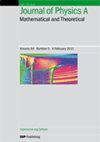从双单元到双单元:可精确求解的多体量子动力学的二分类模型
IF 2.1
3区 物理与天体物理
Q2 PHYSICS, MATHEMATICAL
Journal of Physics A: Mathematical and Theoretical
Pub Date : 2024-07-30
DOI:10.1088/1751-8121/ad653f
引用次数: 0
摘要
双单元砖砌电路是一种可精确求解的多体混沌量子系统模型,它基于在时间和空间方向上都是单元的 2 位门。普罗森最近描述了另一种称为双单元相互作用圆面的模型,我们在此称之为钟表,它基于以非砖块结构组成的 2 控 1 位单元,但具有许多同样吸引人的全局特性。我们提出了一个同时概括这两种现有模型的两分类框架,并用它来证明砖砌电路和发条电路可以产生丰富的相互作用,从而产生新型的广义异构电路。我们证明,这些相互作用受量子组合数据的支配,我们对这些数据进行了精确描述。这些广义电路仍然可以精确求解,而且我们证明它们保留了原始模型的诱人特征,如单点相关函数在除因果光锥之外的任何地方都消失。我们的框架允许我们直接将可解初始状态的概念扩展到这些双元电路,我们还证明了这些电路在经过有限多个时间步骤后,会表现出最大纠缠增长和精确热化。本文章由计算机程序翻译,如有差异,请以英文原文为准。
From dual-unitary to biunitary: a 2-categorical model for exactly-solvable many-body quantum dynamics
Dual-unitary brickwork circuits are an exactly-solvable model for many-body chaotic quantum systems, based on 2-site gates which are unitary in both the time and space directions. Prosen has recently described an alternative model called dual-unitary interactions round-a-face , which we here call clockwork , based on 2-controlled 1-site unitaries composed in a non-brickwork structure, yet with many of the same attractive global properties. We present a 2-categorical framework that simultaneously generalizes these two existing models, and use it to show that brickwork and clockwork circuits can interact richly, yielding new types of generalized heterogeneous circuits. We show that these interactions are governed by quantum combinatorial data, which we precisely characterize. These generalized circuits remain exactly-solvable and we show that they retain the attractive features of the original models such as single-site correlation functions vanishing everywhere except on the causal light-cone. Our framework allows us to directly extend the notion of solvable initial states to these biunitary circuits, and we show these circuits demonstrate maximal entanglement growth and exact thermalization after finitely many time steps.
求助全文
通过发布文献求助,成功后即可免费获取论文全文。
去求助
来源期刊
CiteScore
4.10
自引率
14.30%
发文量
542
审稿时长
1.9 months
期刊介绍:
Publishing 50 issues a year, Journal of Physics A: Mathematical and Theoretical is a major journal of theoretical physics reporting research on the mathematical structures that describe fundamental processes of the physical world and on the analytical, computational and numerical methods for exploring these structures.

 求助内容:
求助内容: 应助结果提醒方式:
应助结果提醒方式:


